
The Loop, one of Chicago's 77 designated community areas, is the central business district of the city and is the main section of Downtown Chicago. Home to Chicago's commercial core, it is the second largest commercial business district in North America and contains the headquarters and regional offices of several global and national businesses, retail establishments, restaurants, hotels, and theaters, as well as many of Chicago's most famous attractions. It is home to Chicago's City Hall, the seat of Cook County, and numerous offices of other levels of government and consulates of foreign nations. In it at the intersection of State Street and Madison Street is the origin of Chicago's street grid addresses, established in 1909. The Loop community area is bounded on the north and west by the Chicago River, on the east by Lake Michigan, and on the south by Roosevelt Road, although the commercial core has greatly expanded into adjacent community areas.
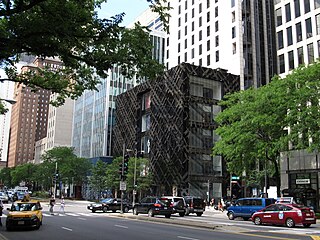
Michigan Avenue is a north-south street in Chicago which runs at 100 east on the Chicago grid. The northern end of the street is at Lake Shore Drive on the shore of Lake Michigan in the Gold Coast Historic District. The street's southern terminus is at Sibley Boulevard in the southern suburb of Harvey, though like many Chicago streets it exists in several disjointed segments.

Clara LouSheridan, known professionally as Ann Sheridan, was an American actress and singer. She worked regularly from 1934 until her death, first in film and later in television. Notable roles include San Quentin (1937) with Pat O'Brien and Humphrey Bogart, Angels with Dirty Faces (1938) with James Cagney and Bogart, They Drive by Night (1940) with George Raft and Bogart, The Man Who Came to Dinner (1942) with Monty Woolley, Kings Row (1942) with Ronald Reagan, Nora Prentiss (1947), and I Was a Male War Bride (1949) with Cary Grant.
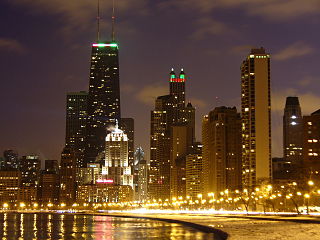
The Near North Side is the eighth of Chicago's 77 community areas. It is the northernmost of the three areas that constitute central Chicago, the others being the Loop and the Near South Side. The community area is located north and east of the Chicago River. To its east is Lake Michigan, and its northern boundary is the early 19th-century city limit of Chicago, North Avenue. Of the downtown community areas, the Near North Side has the second-largest total area after the Near West Side, the highest number of skyscrapers, and the largest population. With the exception of Goose Island and the remnants of Cabrini–Green, to the west, the Near North Side is known for its extreme affluence, typified by the Magnificent Mile, Gold Coast, Navy Pier, and its world-famous skyscrapers.
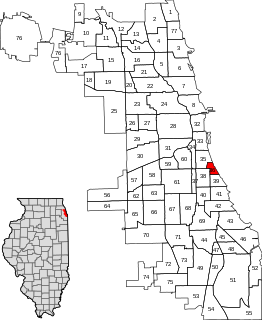
Oakland, located on the South Side of Chicago, Illinois, USA, is one of 77 officially designated Chicago community areas. Bordered by 35th and 43rd Streets, Cottage Grove Avenue and Lake Shore Drive, The Oakland area was constructed between 1872 and 1905. Some of Chicago's great old homes may be seen on Drexel Boulevard. The late 19th-century Monument Baptist Church on Oakwood Blvd. is modeled after Boston's Trinity Church. Oakwood /41st Street Beach in Burnham Park is at 4100 S. Lake Shore Drive. With an area of only 0.6 sq mi Oakland is the smallest community area by area in Chicago.

Washington Heights is the 73rd of Chicago's 77 community areas. Located 12 miles (19 km) from the Loop, it is on the city's far south side. Washington Heights is considered part of the Blue Island Ridge, along with the nearby community areas of Beverly, Morgan Park and Mount Greenwood, and the village of Blue Island. It contains a neighborhood also known as Washington Heights, as well as the neighborhoods of Brainerd and Fernwood. As of 2017, Washington Heights had 27,453 inhabitants.
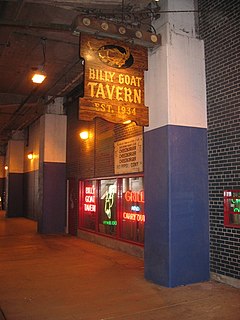
The Billy Goat Tavern is a chain of taverns located in Chicago, Illinois. Its restaurants are based on the original Billy Goat Tavern founded in 1934 by Billy Sianis, a Greek immigrant. It achieved fame primarily through newspaper columns by Mike Royko, a supposed curse on the Chicago Cubs, and the Olympia Cafe sketch on Saturday Night Live.

Harpo Productions is a U.S. multimedia production company founded by Oprah Winfrey and based in West Hollywood, California. It is the sole subsidiary of her media and entertainment company Harpo, Inc. The name "Harpo" is "Oprah" spelled backwards, and it was also the name of her on-screen husband in The Color Purple.

Little Italy, sometimes combined with University Village into one neighborhood, is on the Near West Side of Chicago, Illinois. The current boundaries of Little Italy are Ashland Avenue on the west and Interstate 90/94 on the east, the Eisenhower Expressway on the north and Roosevelt to the south. It lies between the east side of the University of Illinois at Chicago campus in the Illinois Medical District and the west side of the University of Illinois at Chicago campus. The community was once predominantly Italian immigrants but now is made up of diverse ethnic and socio-economic backgrounds as a result of immigration, urban renewal, gentrification and the growth of the resident student and faculty population of the University of Illinois at Chicago (UIC). Its Italian-American heritage is primarily evident in the Italian-American restaurants that once lined Taylor Street. The neighborhood is home to the National Italian American Sports Hall of Fame as well as the historic Roman Catholic churches Our Lady of Pompeii, Notre Dame de Chicago, and Holy Family.

William Warren Boyington was an architect who designed several notable structures in and around Chicago, Illinois. He was also mayor of Highland Park, Illinois.
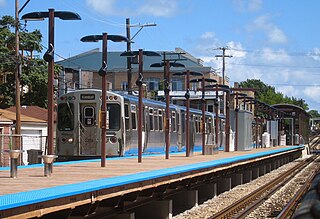
Rockwell is an 'L' station on the CTA's Brown Line. It is an at-grade station with a single island platform, located in Chicago's Lincoln Square neighborhood. The adjacent stations are Francisco, which is located across the Chicago River about three eighths of a mile (0.6 km) to the west, and Western, located about one-quarter-mile (0.40 km) to the east. Rockwell is the last station on the surface section of the Brown Line; between Rockwell and Western the line ascends and runs on elevated tracks for the rest of the route.

Milwaukee Avenue is a street in the city of Chicago and the northern suburbs.

The Isidore H. Heller House is a house located at 5132 South Woodlawn Avenue in the Hyde Park community area of Chicago in Cook County, Illinois, United States. The house was designed by American architect Frank Lloyd Wright. The design is credited as one of the turning points in Wright's shift to geometric, Prairie School architecture, which is defined by horizontal lines, flat or hipped roofs with broad overhanging eaves, windows grouped in horizontal bands, and an integration with the landscape, which is meant to evoke native Prairie surroundings.
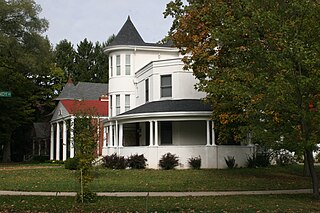
Old Edgebrook is a historic district and neighborhood in the Forest Glen community area of Chicago, Illinois, United States.
The Marquette Golden Avalanche football program, commonly known as the Marquette Hilltoppers from approximately 1940 to 1953 and as the Marquette Warriors from 1954 to 1960, was the intercollegiate American football team for Marquette University of Milwaukee, Wisconsin. The first team was fielded in 1892.
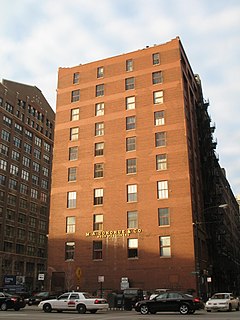
Printer's Row, also known as Printing House Row, is a neighborhood located south of the Chicago downtown area known as the Loop. The heart of Printer's Row is generally defined by Ida B. Wells Drive on the north, Polk Street on the south, Plymouth Court on the east, and the Chicago River on the west. This neighborhood overlaps significantly with the officially designated landmark Printing House Row District. The neighborhood includes Dearborn Station, which is also on the National Register of Historic Places.
Legends South, formerly Robert Taylor Homes, is a neighborhood located in the Grand Boulevard Community Area on the South side of Chicago, Illinois.

The Ida B. Wells Homes was a Chicago Housing Authority (CHA) public housing project that was located in the Bronzeville neighborhood on the South Side of Chicago, Illinois. It was bordered by Dr. Martin Luther King Drive on the west, Cottage Grove Avenue to the east, 37th Street to the north, and 39th Street to the south. The Ida B. Wells Homes consisted of rowhouses and mid- and high-rise apartment buildings and were constructed for African Americans from 1939 to 1941. They were demolished beginning in 2002 and ending in 2011.
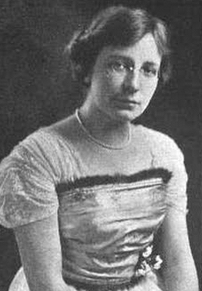
Mae Doelling Schmidt(néeMary Metzke; 22 May 1888 Chicago – 11 March 1965 Chicago) was an American virtuoso pianist, composer, clubwoman, and music educator, from in Chicago. She was on the faculty of the American Conservatory of Music.


















